Day 5: Wednesday, July 5, 2023
We checked out of Hotel Sardonyx Tokyo at 10 a.m. and walked roughly 20 minutes to Tokyo Station, wheeling our luggage behind us. At the Daimaru basement food court, we hunted for ekiben to enjoy on our shinkansen (bullet train) ride to Kyoto. Faced with an impressive array of choices, we settled on 2 Hokkaido potato croquettes for ¥349 and a popular two-box ekiben set marked with a #1 sign, priced at ¥1,274.
The Nokomi 227 departed Tokyo Station's Platform 17 at noon. Our 2 reserved seats (19B & 19C) were located in Car 6. I didn't pay extra for oversized luggage, so thankfully we managed to stow everything on the overhead shelf. One mid-sized suitcase, however, was too heavy to lift, so I had to position it in front of me. Thankfully, the ample legroom between seats made it manageable. The ride itself was swift and quiet, and we slept through most of it.
We left sunny Tokyo at noon and arrived in a rain-kissed Kyoto at 2:15 p.m. It seemed like each time we arrived at a new city, we were blessed with rain showers as a welcome gift.
Navigating to Onyado Nono Kyoto Shichijo Natural Hot Spring Hotel, about 500 meters away from the station, became its own adventure. With luggage in tow and drizzle overhead, I thanked God for helping me discover an underground mall that we could walk through to spare us a soaking. Elevators helped us navigate the various levels, and after exiting the underground walkway, we braved a short stretch with umbrellas to reach the hotel.
By the time we arrived at the hotel, it was 3 p.m. and time to check-in. Stepping into the hotel felt like entering another world. The interiors were lined with tatami mats, thus requiring guests to remove their shoes. We stored our shoes in free lockers provided at the entrance and then helped ourselves to complimentary refreshments in the lobby - the hot chocolate was absolutely delightful!
Our first room was a standard queen - compact, with a queen bed. Wanting more space, I returned to the lobby to request a twin-bed room. For an additional ¥3,000, we were upgraded to Room 631, which offered more comfort and breathing room. The total cost for our 3-night stay came to ¥55,618 ($392), or about $130.67 per night - well worth the upgrade.
The hotel's amenities were top-notch and made the $7 nightly facility fee feel well worth it. In the lobby, guests could help themselves to complimentary slippers, towels, and socks, along with an inviting selection of refreshments including hot chocolate, coffee, and matcha. Elsewhere in the hotel, thoughtful daily complimentary treats were offered: Yakult probiotic drinks available from 5-10 a.m., ice cream bars from 3 p.m. to 1 a.m., and yonaki-soba (half size ramen noodle soup) served between 9:30 and 11 p.m.
In addition to the natural hot springs (Renka no Yu), which are open daily from 3 p.m. to 10 a.m., guests also have access to a sauna that closes each night from 1-5 a.m. Laundry machines equipped with detergent are available for complimentary use, while dryers cost ¥100 per 20 minutes, with a maximum usage time of 40 minutes.
The 3 chair massagers next to the TV lounge were very popular. Despite signage urging guests to be considerate, I spotted someone snoozing away on a chair for quite a while. We learned that the best time to use one was around 3 p.m., just after returning from our day trip. They were usually available at that time, so we would sit on one for a quick R&R.
Overall, the hotel radiated a relaxed, home-away-from-home energy. The subtle Japanese touches were lovely and pleasant. It was by far our favorite hotel of the entire trip, and we missed it so much after we left - it was that special.
After a brief rest, we headed out into the rain, umbrellas in hand, to Kyoto Station for an early obanzai dinner at Minoru Dining - Kyoto Porta. The restaurant is open daily from 11 a.m. to 10 p.m.
Mom and I each ordered the premium Minoru zen, priced at ¥2,420 per set. Each tray showcased a colorful assortment of about 12 beautifully presented small dishes featuring Kyoto-style meats, seasonal vegetables, rice, and miso soup. Obanzai, a traditional Japanese cuisine native to Kyoto, focuses on using fresh, in-season ingredients, with at least half sourced or processed locally in Kyoto. This meal was a true revelation - flavorful, satisfying, and deeply comforting.
The Porta Dining underground mall, where the restaurant is nestled, proved to be a treasure trove of local culinary delights. After dinner, I had the best matcha ice cream ever at Nana's Green Tea, at a very reasonable ¥500 per cone.
On our walk back to the hotel, we stopped in at Lawson once more to get some snacks: a bottle of green tea for ¥138, two cups of flan desserts for ¥328, 3 soft-boiled eggs for ¥351, and a tuna salad onigiri for ¥135.
Later that evening, I had my first experience with a Japanese communal bath - Mom decided to skip it. Clad in the hotel's pajamas, I made my way down to the natural hot springs. The bath areas were separated by gender, and to access the women-only section, I entered a pin code given at check-in. I chose a locker and stashed away my clothes, slippers, and the bath basket provided in our room.
Walking nude into the bathing area was definitely outside my comfort zone. I was greeted by the sight of women showering in short shower stalls, each equipped with a low plastic stool, shampoo, conditioner, and facial and body soap. I found one and proceeded to shower next to other butt naked women.
After rinsing off, I immersed myself in various baths - there were 6 in total. I preferred those set at a soothing 40°C. The first dip was the best as it felt as though every ounce of stress within me quietly dissolved in the hot water. I didn't linger too long though. I rinsed once more, returned to the changing room, got dressed, and blow-dried my hair.
To cap off the bath experience, I rested in the TV lounge and had a chocolate ice cream bar and a refreshing cup of chilled water. I felt SO relaxed after the bath. It was truly phenomenal.
At 9:30 p.m., Mom and I went downstairs for free bowls of ramen. Because most of the guests were dressed in the same brown hotel clothes and lining up for free ramen, I couldn't help but think how everyone resembled inmates lining up for rations. It gave us a chuckle. The broth was salty, the noodles chewy. It was a one-off experience as we opted not to repeat the following nights.
Day 6: Thursday, July 6, 2023
We took a bus back to the hotel for some afternoon rest. As mentioned earlier, one of the highlights of our stay was the hotel's incredible amenities. Before soaking in the natural hot springs, we enjoyed a session on the massage chairs - a perfect reset for tired muscles.
With several days' worth of laundry piling up, I did laundry next. Washing was free, and the 40-minute dryer cost just ¥200 - a steal for clean, dry clothes. As we waited, we sipped hot chocolate and matcha, feeling perfectly content in that quiet moment.
An unexpected highlight came in the form of two teenage Japanese boys, also guests at the hotel. When we met at the elevator, they greeted us warmly, and before exiting, offered a respectful bow. Their gesture was simple, yet deeply impressive - a beautiful reflection of Japanese etiquette that left a lasting impression.
Dinner followed at Kyoto Station's Porta Dining. We chose tonkatsu at Tonkatsu KYK - Kyoto Porta, where two 110g pork cutlet sets came to ¥2,800. With free salad refills and satisfyingly crispy tonkatsu, it was a hearty end to a gentle, restorative day.
Day 7: Friday, July 7, 2023
From Kiyomizudera Temple, we began a self-guided walking tour to Pontocho Park, following a route mapped out via Google Maps. We covered at least 3.3 km on foot - excluding the detours we took to explore temples and gardens, pause for breaks, and indulge in a little shopping.
Our first stop was the historic slopes of Sannenzaka and Ninenzaka - iconic Kyoto streets lined with traditional merchant houses called machiya. These winding lanes are home to an array of shops selling locally crafted goods, inviting cafés, elegant teahouses (ochaya), restaurants, and inns. Steeped in history, Sannenzaka was built in 808 as a ceremonial approach to Kiyomizudera, while Ninenzaka, dating to 807, is famed for its postcard-perfect view of the 5-storied Yasaka Pagoda.
Along Ninenzaka, we paused outside the world's first tatami Starbucks, creatively renovated from a teahouse over a century old. Sadly, it was full at the time, so we continued our stroll through the enchanting streets. Thanks to their cultural significance, the buildings along both slopes have been carefully preserved, ensuring that their timeless beauty remains intact.
Now in the heart of the Higashiyama district, I paused in the middle of Yasaka Street for the best spot for a photo on Ninenzaka slope with the 5-storied Yasaka Pagoda rising in the background. Built in 592, Yasaka Pagoda holds the honor of being Kyoto's oldest.
From there, we wandered into what's often described as the most beautiful lane in all of Kyoto - Ishibeikoji Alley/Lane. This narrow, stone-paved passage stretches less than 200 meters, winding gently and reserved for pedestrians only. Tucked off Nene-no-Michi Lane, it exudes a timeless charm with its secluded atmosphere and traditional architecture, offering a brief but memorable detour into the poetic soul of the city.
Next, we made our way to Kennin-ji Temple, founded in 1202 and considered the oldest Zen temple in Kyoto - perhaps even in all of Japan. The entrance fee was ¥600 per adult, with daily opening hours from 10 a.m. to 5 p.m.
There was a shoes-off policy, so thankfully, we were wearing socks! We were given red slippers to cross over to an adjacent building.
The highlights of our self-guided tour were striking: the iconic painted screen of Fujin and Raijin, Japan's legendary gods of wind and thunder; a breathtaking ink mural of twin giant dragons sprawling across the ceiling; and the immaculately landscaped Zen gardens, each a quiet testament to stillness and contemplation.
































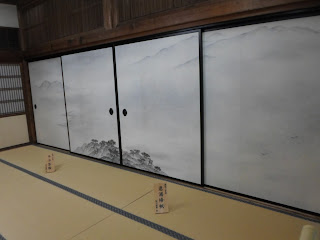







































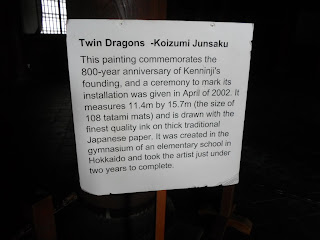





For lunch, we walked to Kamanza, a serene spot known for serving authentic Kyoto cuisine. We each ordered the namafu cold soba set, which came with crisp mixed tempura and delicate yuba (tofu skin); each set was priced at ¥2,160.
Dessert brought its own sense of ceremony: 3 sticks of namafu dengaku (steamed wheat and mochi rice flour brushed with sweet miso sauce) cost ¥1,150. We topped off the meal with scoops of matcha ice cream (¥480 each). The total came to ¥6,430, but it was worth it.
After lunch, we walked north under the scorching sun (thank goodness for our umbrellas) toward Yasaka Shrine, located in Kyoto's Gion district, famously known for its geisha culture. Built in 656, Yasaka Shrine serves as the host of Kyoto's largest and most iconic summer celebration: the Gion Festival (Gion Matsuri), which dates back to 869 and now spans the entire month of July. On select dates, elaborate float parades roll down Kyoto's main streets, drawing visitors from all over the world.
Entry to the shrine is free, with opening hours from 10 a.m. to 5 p.m. We entered through the grand red Nishiromon Gate, but unfortunately couldn't visit the main hall, a masterpiece of Gion Zukuri Japanese shrine architecture completed in 1654.
Then came a sweet surprise - a group of four Japanese junior high school boys stopped me in my tracks and politely asked, in English, if they could take a photo with me. It was part of a school field trip assignment, so I happily agreed. They ended our brief encounter with a cheerful, "Have fun." 


























Once in the heart of the Gion district, we strolled down the bustling Shijo-dori, a lively street filled with shops and restaurants catering to curious travelers and locals alike. We chose to pass on the kimono rentals, geisha makeover experiences, and visits to ochaya - traditional teahouses where geikos (Kyoto's geishas) and maikos (their apprentices) perform tea ceremonies, dances, and shamisen music played on a three-stringed lute.
Instead, we gravitated toward the serenity of Shirakawa Lane - a peaceful retreat along the Shirakawa Canal. Flanked by graceful weeping willows and blooming hydrangeas, it was the perfect setting for a tranquil hanami (flower-viewing) walk. We crossed the canal using the charming Tatsumibashi Bridge, which offered a picturesque view that felt both timeless and lovely.




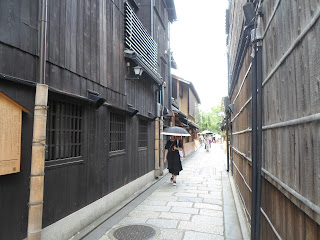















Finally, we wandered westward, crossing the Kamogawa River toward Pontocho Park, where we found ourselves immersed in a tapestry of more traditional alleyways and atmospheric corners. This area offered yet another glimpse into Japan's cultural soul - narrow passages steeped in charm, framed by lanterns, wooden facades, and whispers of old Kyoto.
By 2:15 p.m., we caught a bus back to the hotel. A session on the massage chairs offered the perfect prelude to my next indulgence: an afternoon dip in the onsen. The warmth of the natural hot springs soothed every step of the journey, leaving me feeling grounded and deeply at peace.
After a restful couple of hours at the hotel, we made our way back to Kyoto Station's Porta Dining for dinner at Ippudo - Kyoto Porta. Luckily, there wasn't much of a wait when we arrived, but by the time we left, the line had noticeably grown - a testament to the restaurant's popularity.
We ordered the regular ramen with a soft-boiled egg and original noodles for ¥990 per bowl (tax included). Dad commented that it was the lightest meal we'd had so far.
After dinner, I bought 2 boxes of matcha chocolate daifuku for ¥1,512 (with tax). I also bought 4 pastries for the next morning's breakfast (¥1,010). Mom sweetly offered to cover the matcha soft serve ice creams (¥500 each) and even bought a can of matcha latte powder (¥1,170) for me to take home.
Previous Post: Tokyo, Japan: July 1-5, 2023



































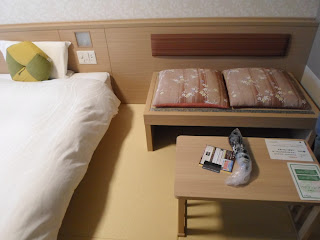

































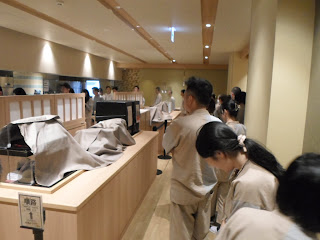










































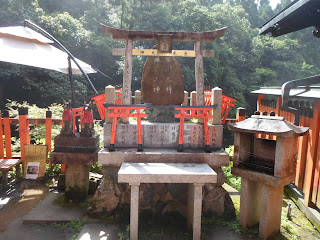














































































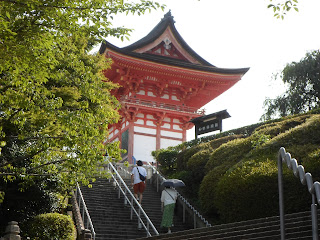

















































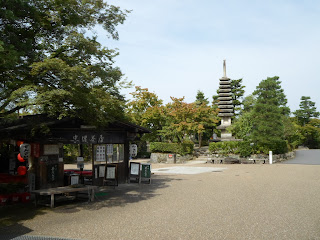

































































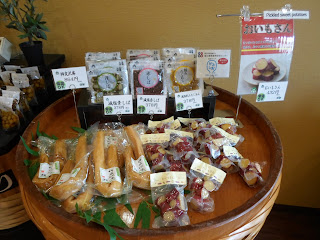











































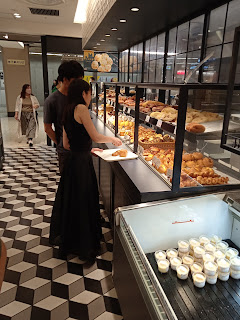



No comments:
Post a Comment